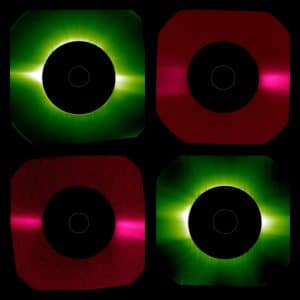
First high resolution images of our sun at 121 nm from Solar Orbiter, a Sun-observing mission by ESA and NASA. These images were taken during the commissioning of EUI and Metis instruments, that are equipped with ProxiVision´s 40 mm Image Intensifiers.

The first images taken with the High Resolution Imager, HRILYA telescope, as part of the Extreme Ultraviolet Imager (EUI) are showing the solar atmosphere below the hot corona. The images show the solar surface in a particular ultraviolet wavelength, known as Lyman-alpha and has a wavelength of 121.6 nm, that is produced by hydrogen. The “network” structure seen in the images is characteristic of a region of the solar atmosphere known as the chromosphere.
Metis Instrument achieved three “world firsts” during commissioning:
- First time taking images of the extended corona in UV light
- First time taking visual and UV light images simultaneously
- Highest resolution ever reached with a coronograph thanks to its proximity to the Sun (77 million km)
“The Metis coronagraph measures simultaneously for the first time visible and ultraviolet emissions of the solar corona with unprecedented temporal coverage and spatial resolution” (Marco Romoli, Metis Principle Investigator)

Its first light images, taken on 15 May 2020, and displayed here in the left hand column, are the first simultaneous images of the corona taken in both visible light (580-640 nm) and ultraviolet light (UV, 121.6 nm). On the right-hand side are the simultaneously captured visible and UV images taken on 21 June 2020, soon after Solar Orbiter´s first perihelion.
The images are showing the two bright equatorial streamers and fainter polar regions that are characteristic of the corona during times of minimal magnetic activity.
ProxiVision´s Image Intensifiers that are integrated in both instruments EUI and Metis are sensitive to EUV (extended UV light) and are optimized for the Lyman-alpha regime (121.6 nm). The detectors are specially designed in close cooperation with the Max Planck Institute for Solar System Research for the Solar Orbiter mission.

Further images taken with our detectors:
EUI:
https://www.esa.int/ESA_Multimedia/Images/2020/07/Solar_Orbiter_s_high-resolution_view_of_the_Sun
https://www.esa.int/ESA_Multimedia/Images/2020/07/Solar_Orbiter_s_high-resolution_view_of_the_Sun5
https://www.esa.int/ESA_Multimedia/Images/2020/07/Solar_Orbiter_s_high-resolution_view_of_the_Sun4
https://www.esa.int/ESA_Multimedia/Images/2020/07/Solar_Orbiter_s_high-resolution_view_of_the_Sun6
https://www.esa.int/ESA_Multimedia/Images/2020/07/Solar_Orbiter_s_high-resolution_view_of_the_Sun3
https://www.esa.int/ESA_Multimedia/Images/2020/07/Solar_Orbiter_s_high-resolution_view_of_the_Sun2
METIS:
https://www.esa.int/ESA_Multimedia/Images/2020/07/Solar_Orbiter_s_first_view_of_the_Sun_s_corona2
https://www.esa.int/ESA_Multimedia/Images/2020/07/The_Sun_s_corona_in_visible_light_on_15_May_2020
https://www.esa.int/ESA_Multimedia/Images/2020/07/The_Sun_s_corona_in_visible_light_on_21_June_2020
https://www.esa.int/ESA_Multimedia/Images/2020/07/Solar_Orbiter_s_first_view_of_the_Sun_s_corona





